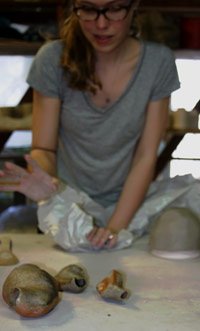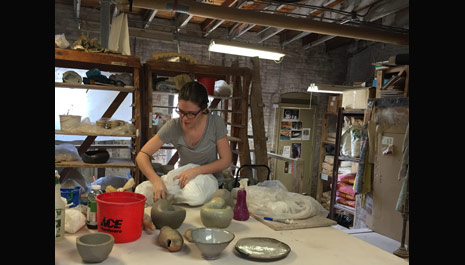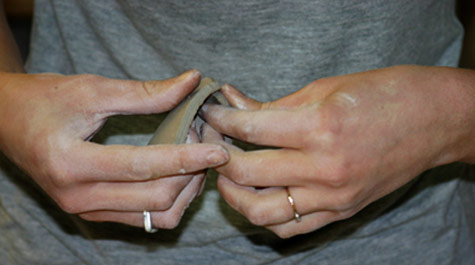Comfortable with clay: W&M art student wins VMFA Fellowship
Zoë Powell ’16 is probably as at home in the Old Power Plant’s Ceramics Studio as she is anywhere. As she talks, the dual biology and art major deftly cuts a piece of clay from a huge block and begins kneading it as effortlessly as experienced bakers work bread dough.
In only her second year of studying ceramics, the Richmond native has already achieved some success. She was recently announced as a recipient of a Virginia Museum of Fine Arts Fellowship, designed to support Virginia’s best artists and most promising art students. Powell was one of 27 artists recognized for “excellent creative ability,” only 10 of whom were undergraduates. The fellowship came with a $4,000 award.
“Zoë Powell is a remarkable student,” said Elizabeth Mead, art & art history department chair. “She has an exquisite sense of form and materiality that marry together her studies in art and biology.”
{{youtube:medium:left|7redU3CBJB4}}
Although ceramics is relatively new to her, Powell’s background in art dates to kindergarten, when she began taking studio classes outside of school.
In high school, Powell was in the International Baccalaureate program. She specialized in art for four years, putting on exhibitions and working in the gallery her final two years.
She continued studying art at the same studio but now she was also teaching elementary school students – sometimes rudimentary ceramics.
“So I had experience with clay, but never real ceramics. It was always like Bugs Bunny figurines and things like that,” she said. “When I came to William & Mary and saw that they had a ceramics department and I had [Ceramics Assistant Professor] Mike [Jabbur] as my major advisor, I was determined to take his class. I’ve been doing something with clay every semester since.”
Even over breaks, Powell is working with clay. Last summer she interned at the Visual Arts Center of Richmond and volunteered with the fledgling Old Tavern Kiln Collective in Quinton. This summer, she has a residency lined up at the Cub Creek Foundation, an advanced ceramics study program in Appomattox, Virginia.
 Powell said that ceramics allows her to inform her art with an understanding of biology. “It’s subtle,” she said. “It’s not a direct reference. I don’t want to be the person who makes little bushes or flowers out of clay. So they are like organs, or like flesh being stretched over a bone structure.”
Powell said that ceramics allows her to inform her art with an understanding of biology. “It’s subtle,” she said. “It’s not a direct reference. I don’t want to be the person who makes little bushes or flowers out of clay. So they are like organs, or like flesh being stretched over a bone structure.”
In the Ceramics Studio, she handles one of the heavy vases – she calls them “sunken vases” – that were featured on the Virginia Museum of Fine Arts’ website. “So this could be some kind of animal that’s curled up, or slumped in. It doesn’t have to necessarily be something from my biology textbook.”
She gestures to a set of smaller wood-fired vases and points to their rough details. “These look like objects you might find walking on a path in the woods, like little rocks, or this could be some kind of bark. Some of it is intentional and some of it just happens to come out from techniques I try, but can never exactly predict the outcome. I want to work more functionally, but I always steer myself toward this abstract, decorative aesthetic. It’s just something I’m drawn to, these organic, nonfunctional pieces.”
Next school year, Powell plans to take wheel throwing for the first time. After graduation, she said she will take a year off before graduate school. Some ideas: setting up an Etsy shop and using the fellowship award to open a temporary gallery in Richmond or to visit Japan to study under a ceramics master.
“I think that year off is really important because I’ll learn how to prompt myself and learn how to live without a professor,” she said. “That’s huge for any artist. I’ll learn how to advertise myself and sell my works.”


















